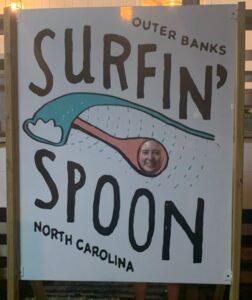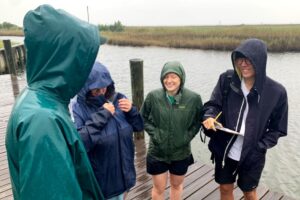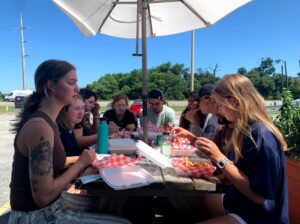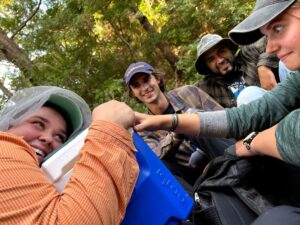Hello! My name is Jane Bailey and I’m a senior studying Chemistry and Environmental Science. The OBXFS ‘21 session is my second to last undergraduate semester and I am excited to share my internship experience! The internship portion of the OBXFS was hands down one of my favorite elements of the semester. From hands-on experience in the marshes of Currituck Banks to productive days addressing resource and community management at the Parks and Wildlife Department Headquarters, my internship has helped develop my career skill sets for my future goals in academia and research.
For my position, I knew that I wanted to gain more experience with field work; I love being outside and doing hands-on research, just like our capstone work! Learning field research methodologies are critical to environmental science research and I wanted to capitalize on this while at the field site. Luckily, Linda D’Anna paired me with Erik Alnes, the Northern Sites Field Manager, of the North Carolina Coastal Reserve.
Erik is an amazing internship supervisor; he is extremely knowledgeable, hands on, down to earth, and very passionate about his work. Once we got together for our initial conversation about goals and expectations, he introduced me to the project we would be working on. In the Outer Banks, there are several designated conservation areas that are managed by the Coastal Reserve for research and resource preservation. One of these is Currituck Banks which is in the northern portion of the OBX. The proposed project was a survey of sub aquatic vegetation (SAV) within the sound and marsh systems of the bay; a novel survey which had never been conducted before! I was excited to be a spear header on this project as SAV ecosystems are critical habitat for fish nurseries, food systems for migrating bird species, and are for water filtration within the estuaries. For the survey, we would go out into the estuary, observing SAV species diversity, community composition, and depth at which the species could be found on a series of pre-mapped transects stretching out into the bay. From there, we would map the data found during the surveys and analyze if any trends emerged in terms of species composition and depth profiles where the communities were growing.
What a great project to be working on!! I was excited to be contributing to a wider array of scientific knowledge and further outlining the natural resources that existed within Currituck Banks. One of our goals for the future was to make this survey an annual process to temporally and spatially map SAV species throughout Currituck, which would be made possible if the first survey was a success. So I said to Erik, “Let’s do it!”
Our survey day was, in total transparency, one of my favorite days at the OBX. Getting to spend my day, knee high in the sound, under the sky on a beautiful afternoon was everything I pictured when I told myself that I wanted to become an ecologist. The pine forests with live oak understories, sandy wading inlet, and marsh surrounding us during the survey was an absolutely gorgeous setting for a research day. During the survey, we were also met by two other individuals from the Coastal Reserve that wanted to be involved with the data collection, as well as an individual from the United States Geological Survey who wanted to learn about our methodology and survey tactics. It was great getting to meet other individuals in my field of study and discuss our areas of focus, all while wading around in the middle of the sound!
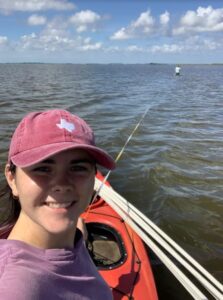
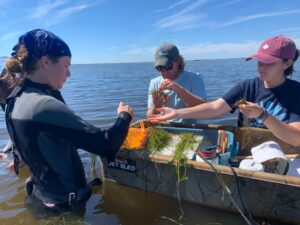
Digging into the meat of the survey, we snorkeled to count species area cover within our plots and community composition of our transects; we identified eight species of SAV within the sound with our most prevalent species being native celery grass, compromising 55% of the SAV species we observed. After moving through transects A-C, we had spent the better part of the day in the water and were ready to head back to base, exhausted but excited to have collected our data. Throughout the subsequent days, Erik and I proceeded to ID any unknown species, updated our SAV Easy ID pamphlet, updated the methodology report for the SAV survey, and plotted our data on ArcGIS to better visualize our findings. From start to finish, this was a great project that I loved to have contributed to. From being outdoors, to analyzing findings, and coming up with great visuals to better represent the SAV species of the sound, I loved doing this type of research!
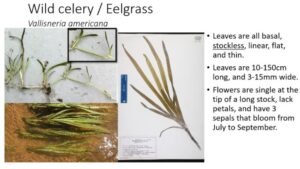
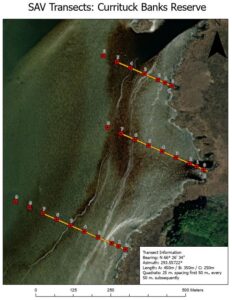
In addition to the main project, Erik taught me about reserve management, aspects of trail maintenance, community interaction (lovingly termed “PR”), and other odds and ends that were in a day in the life of a Norther Sites Manager. Overall, I thoroughly enjoyed my work with the Coastal Reserve and the experiences I gained there helped me learn which pathways I’d like to pursue in the future, along with additional skill sets to achieve those goals. If I’d have to give a piece of advice to anyone searching for their internship at the moment, I’d say that this experience is critical to learning what you want to do just as much as what you don’t. Don’t be afraid to ask questions, our mentors are here to help us, and you get as much out of the internship as you put in. Make it yours!
**If you are interested in resource management, community stakeholder engagement, a balance between office and field work, a dynamic and engaging work environment, and an internship focused around the outdoors, keep the Coastal Reserve in mind!**
— Jane Bailey, OBXFS 21
